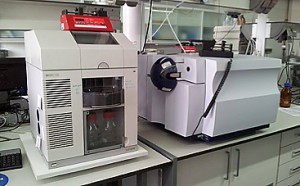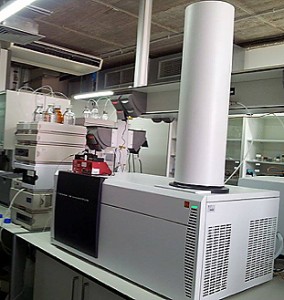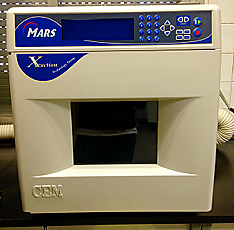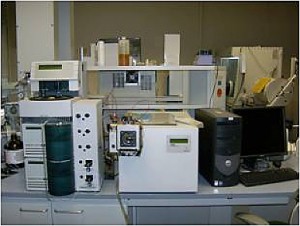Scientific equipment available for the program
The groups involved in the program have a number of instrumental analytical techniques, which make up much of the necessary infrastructure to carry out the program and which are available to the rest of the groups involved. They are described below:
UAH-QA | CSIC-AI |CSIC-AA | UCM-QA | UNED-QA | Lab284 | Lab147
UAH-QA
- 4 capillary electrophoresis equipments with diode array (DAD) detection
- Liquid chromatograph with fluorescence detection
- Liquid chromatograph with DAD detection
- Micro liquid chromatograph with DAD detection
- Semipreparative liquid chromatograph with DAD detection
- Electrospray quadrupole-time-of-flight (QTOF) Mass spectrometer
- Electrospray ion trap (IT) mass spectrometer
- Isoelectrofocussing system (offgel)
- Gel electrophoresis system
Capillary electrophoresis equipment coupled to IT mass spectrometer
Liquid chromatograph coupled to QTOF mass spectrometer
The group has also access to different centers of support for research at the University of Alcalá, highlighting the Centre for Chemical and Microbiological Analysis (CQAB), and the Biology-Medicine Center (Crop Unit). In addition, the CQAB participates in the consortium as laboratory from REDLAB.
CSIC-AI
- 2 Gas chromatographs with flame ionization detector (FID)
- 3 Gas chromatographs coupled to quadrupole mass spectrometer
- Two-dimensional gas chromatograph GC x GC, with electron capture detector
- Gas chromatograph coupled to triple quadrupole mass spectrometer
- Gas chromatograph with electron capture detector
- Gas chromatograph coupled to mass spectrometer with chemical ionization system
- Multidimensional gas chromatograph (heart-cut) with electron capture detectors
- Pressurized liquid extractor
- Equipment for microwave assisted extraction
- UV-Vis equipment with fixed wavelength
- Two-dimensional gas chromatograph GC x GC coupled to time-of-flight (TOF) mass spectrometer
- HPLC system coupled to quadrupole mass spectrometer
- UPLC system coupled to triple quadrupole mass spectrometer
CSIC-AA
- Liquid chromatography coupled to different detectors: UV-Vis, fluorescence, refractive index, mass spectrometry (MS, MS/MS, QTOF).
- Gas chromatography with flame ionization detector (FID), mass spectrometry
- Capillary electrophoresis coupled to UV-Vis detection
- Plate Readers (ultraviolet, visible, fluorescence)
- Semi-preparative chromatography
- Pilot plants and laboratory of cell cultures from ICTAN
UCM-QA
Equipments for the separation, identification and determination of trace elements and their species, organic compounds and metal nanoparticles. Equipments for proteomics study:
- ICP-MS HP 7700
- ICP-MS Thermo SeriesX2
- AF4 2000 AT series. Postnova Analytics
- ESI/MS QTOF API US MICROMASS WATERS
- AAS-Zeeman
- EI-LTQ-MS Thermo
- Laser ablation-ICP-MS Agilent Cetac
- GC-microECD-MS
- LC-FL Thermo P4000
- CV-AFS
Equipments for sample preparation:
- Laminar flow cabinet
- Electrophoresis OFFGEL
- Concentrator
- Centrifuge Eppendorf
- Centrifuge Eppendorf 5415 R
- Lyophilizer
- Thermomixers
- Focused ultrasound probes
- Microwave for digestion of samples
The group has access to all services of centers of support for research among which include the CAI of microscopy (very useful for characterization of NPs, and evaluation of cytotoxicity by flow cytometry).
UNED-QA
- Liquid chromatograph with diode array (DAD), fluorescence and conductimetric detection.
- Gas chromatograph coupled to mass spectrometry
- Liquid chromatograph coupled to mass spectrometry.
- Microwave
- Spectrophotometer UV-VIS
- Spectrofluorometer
Lab-284
- ASAP 2020 Micromeritis equipment

- Liquid chromatograph coupled to mass spectrometry Varian 1200/1200L
- Capillary electrophoresis equipment P/ACETM MDQ from Beckman Coulter
- UHPLC Dionex coupled to mass spectrometry ion trap from Bruker
Lab 147
In the Center are eight analytical laboratories with different equipments. Some of the equipments that are available are listed below:
- Plasma Emission Spectrometer ICP, Liberty Axial Serie II, Spectrophotometer UV-Vis (Model Cary I-Bio), Spectrophotometer of fluorescence (Model Cary Eclipse).
- Gas chromatograph GC (Model Star CX 3800/AS 8200) and head-space (Modelo Saturn 2000)
- Gas chromatograph 7890B coupled to mass spectrometry 5977A from Agilent
- 6 Liquid chromatographs HPLC with DAD detection
- Chromatograph HPLC with DAD and fluorescence detection
- Chromatograph HPLC with ELS detection
- Preparative Chromatograph HPLC Dynamax with 2 bombs SD-1
- HPLC-MS Agilent 1100-MSD-20
- Capillary Electrophoresis system Agilent CE
- HPLC coupled to Triple Quad LC/MS de Agilent 6410
- Ionic chromatograph 850 Metrohm
- Spectrophotometer IR, Nicolet Impact-410
- Viscometer Schott Visco Easy Plus.
- Rheometer Haake Mars.
- Differential Scanning Calorimeter Mettler-Toledo DSC-822
- Microwave Milestone.
- Titrator 702SM Tritino Metrohm
- Titrator Karl-Fischer 701KF Tritino Metrohm
- KF Coulometrico 831 Metrohm con Thermoprep 860
- 3 climate chambers Binder 700 L
- Fash Biotage SP-1 system
- Lyophilizer
Service Offer
The groups that are part of the program have their human resources dedicated to research and teaching at university level. This limits their ability to offer services for routine analysis to external sectors, as some analytical companies on the market make. On the other hand, the potential of knowledge and infrastructure that is accumulated in the program, should be used in their social environment, while retaining their main objectives of research and university teaching. All the media and the results obtained with the same will be screened on the following groups:
a) The scientific community, through counseling and the instrumental facilities to other groups that request them and, of course, by communicating of the obtained results in scientific journals and conferences.
b) The business sector, with which it is possible to establish agreements and contracts for delivery of analytical advice services when the company in question does not have the means to solve their problems. The wide variety of problems associated with the establishment of quality and safety in the food industry and the sheer volume of regulations and legislation to be met by food, seems to indicate that this collaboration can be very useful.
c) The Administration, in its various local, regional and national levels. The cooperation of the program with the various bodies responsible for ensuring the purity and quality of food can be very useful on a regular basis and especially when some kind of food scares appear as, unfortunately often happens with some frequency. The program can be a suitable tool and ready to establish and operate appropriate technical measures immediately, to solve the problems arising.












